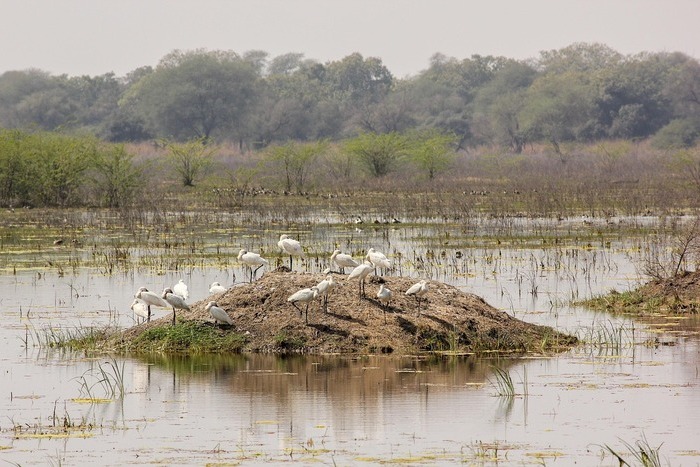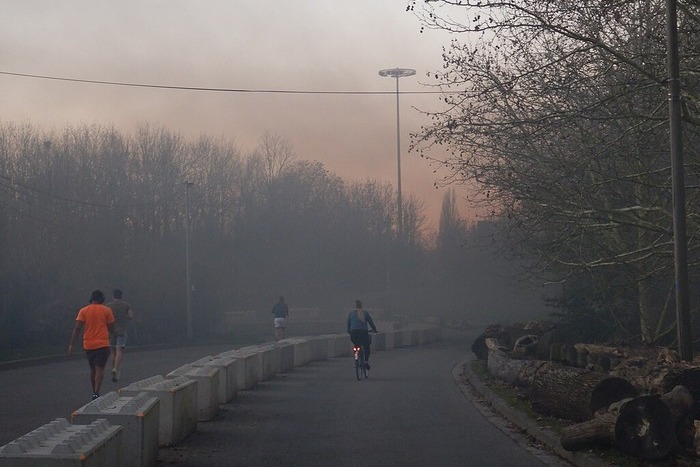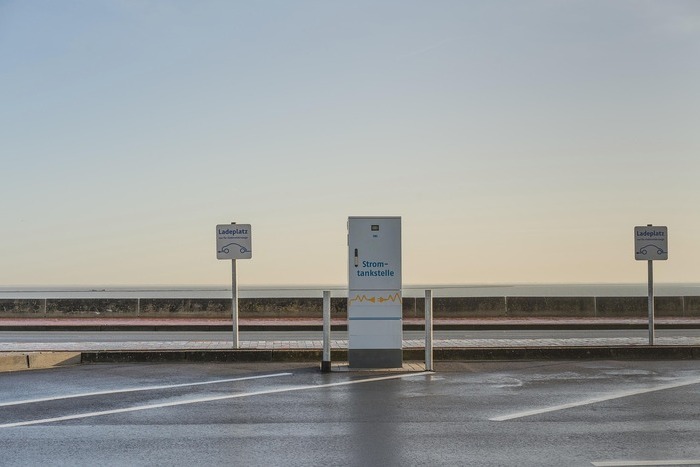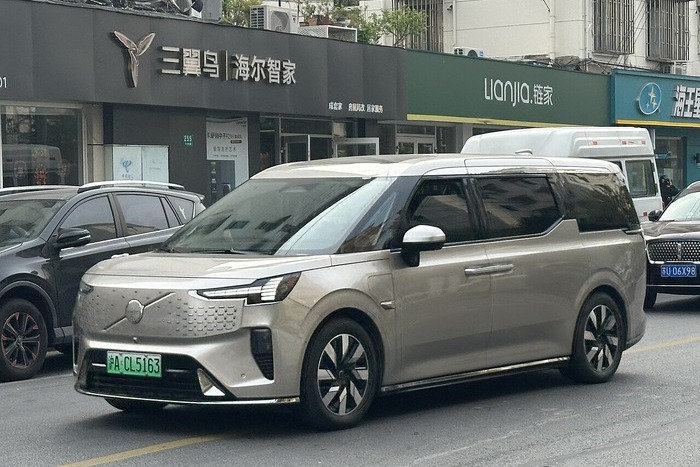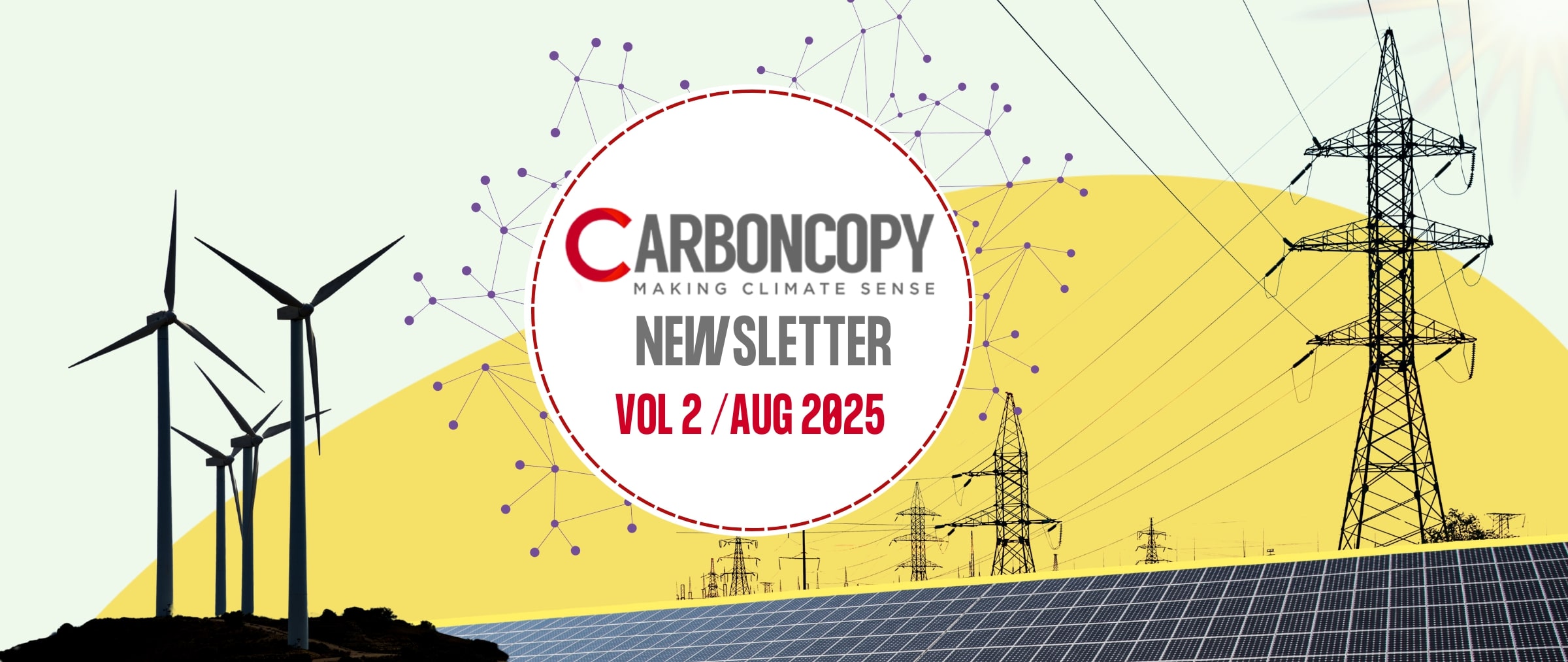
Creatives: Riddhi Tandon
50% green energy was the easier part. The real challenge begins now
India has hit 50% clean capacity ahead of schedule. But translating capacity into real supply, and building the system around it, is proving to be much harder
India has crossed a symbolic halfway mark in its clean energy journey. The Indian government recently announced that half of the country’s power generation now comes from non-fossil sources — a Paris Agreement target met ahead of time. In the past decade, the installed capacity of renewable energy (solar + wind + small hydro) in India has quadrupled. The country added large hydro to the calculation and breached the 200 gigawatt (GW) milestone of green energy capacity in 2024, out of the total installed capacity of 490 GW.
The growth is indeed phenomenal. But here’s the catch. Clean energy capacity doesn’t equal clean energy supply. Renewable energy’s (RE) share in electricity supply remains sub-par when compared to its installed capacity. At the same time, major energy guzzlers, especially industries and electric mobility, remain dependent on fossil-fuel-based power.
RE may make up more than 50% of capacity on paper, yet their actual grid supply has remained around 15-20% over the past several years. The country is backing down on solar power during low demand periods to keep its grid stable. RE project developers are watching their projects go idle because of a lack of interest from states to buy power from them.
India’s energy transition has hit a point where adding RE capacity is no longer enough. What it needs to build, say experts, is a backbone, which includes storage, transmission, transition fuels and smarter planning. Only then can the country turn the RE surge into reliable power.
The Base and the Bridge
India’s power grid was built around coal. Too much RE has already started straining it. Experts have repeatedly pointed to the lack of grid scale energy storage as a major deterrent to round-the-clock RE in the country. But battery energy storage solves only a part of the problem. It would make RE available during non-solar and non-wind hours, but grid level issues would remain, especially when it comes to uninterrupted supply and managing sudden demand spikes.
India’s grid operator, Grid India, goes back to relying on coal power as soon as high demand months hit. These are also the months that coincide with high solar and wind generation, hurting RE projects when it matters the most.
For the grid to manage 200 GW of RE now and 500 GW by the end of this decade, it requires a base power source such as coal in the same quantum and bridge fuels such as gas, hydro or pumped hydro storage to balance the irregular injection of RE.
“In the past 5-7 years, we forgot about base load. We might keep saying coal is black or grey or not green. But let’s accept the fact that RE alone cannot meet the country’s demand,” says ICP Keshari, former secretary, union ministry of power. Keshari, who is now director general of Association of Power Producers (APP), says India would require base load in the same quantum or even more than the RE capacity being planned. “In the Indian context, base power has to come from coal until we are in a big way on nuclear,” he adds.
Gas, say experts, can be that short-term bridge. Keshari says if Europe can call gas a ‘bridge fuel’ then why can’t India?
Dr Debajit Palit, Centre Head, Centre for Climate Change and Energy Transition at Chintan Research Foundation (CRF) agreed. “We have to analyse how best we can meet the demand based on the current technology. I cannot wait till 2050 to meet my aspirational demand. The country’s demand is increasing, and it is important to meet that demand.” CRF is established by the Adani Group. Dr Palit is an energy policy researcher and was earlier professor at NTPC School of Business.
“As a country we have to increase that per capita consumption. Our electricity consumption is not even within the range of other developing countries — it’s less than 1,500 kilowatt hours. In 2047, the projection is about 3,500 kilowatt hours, which is the global average right now,” Dr Palit says. As energy consumption increases, this country should not and cannot wait for some cleaner and newer technology to come in and use it, he adds.
He also points out that gas can meet that demand while also creating infrastructure that can be used later to blend hydrogen, much like what Europe is doing.
Transmission Troubles
India saw its first wave of the RE boom in Rajasthan and Gujarat. But those states are now facing a problem of plenty. Nearly 60 GW of surplus projects are stuck without transmission lines. The gap between generation and transmission has returned to haunt the power sector.
Keshari says, “Transmission was lagging when thermal power was coming up in a big way two decades ago. Now, when RE is coming in a big way, again transmission is a bottleneck.” Lack of transmission was one of the primary reasons for the Non-Performing Assets (NPA) crisis in the thermal power sector during the last decade, which left close to 40 GW of coal-based projects without any takers. “We must find a way to get more transmission in a timely and efficient manner,” he says.
Approximately 40 transmission projects awarded in the past few years, set for commissioning in the current and next financial year, are yet to receive power connectivity approval from the Central Transmission Utility (CTU). Some others have requested extensions to their construction timelines, as there is no certainty that corresponding RE projects will finish on time.
Sector executives say project developers have repeatedly raised the issue of lack of connectivity. “Renewable energy project developers blame it on right-of-way. The transmission sector is also currently facing a a manufacturing supply chain problem,” says an industry executive.
The Centre is slowing down RE tenders until transmission catches up, while also pursuing states to bolster their intra-state electricity supply network.
But experts feel the deeper issue is centralised planning. States need to be given more control over their energy mix.
“You cannot have a top-down approach where the Centre dictates what energy source needs to be promoted. The larger electricity act and the reform part of it should be taken care of by the central government, including how the regulations should work or how policy making should work. But which source of energy should be promoted, should be left to the states,” says a veteran sector observer.
Another area, which has largely remained ignored in energy planning, but will play a significant role as demand rises to historic highs is ‘demand side management’ (DSM), say experts. DSM pertains to building precise demand projection models and managing consumption load through energy efficiency models.
“Demand response and demand management is the one thing that is discussed very little. We are all obsessed by supply side options, renewable and nuclear etc. A lot of service can be done to the country by looking at the demand response,” says Mohit Bhargava, former CEO, NTPC Green.
He says this model would require the most cooperation from states and it is time they are heard more in the energy planning of the country. “Every state needs a multi-pronged strategy to handle this demand management process. Give the states what they want,” says Bhargava.
“The states today probably don’t want solar alone. Give them solar plus storage — if they want a two-hour storage or a four-hour storage or whatever suits them. If the states don’t need 50 gigawatts and they need only 10 gigawatts, let’s give them only 10 gigawatts. If the states want more wind or more FDRE [Firm and Dispatchable Renewable Energy], so be it.”
He adds the issue of unsold PPAs is emerging because the market is not absorbing that capacity. “We keep saying we will do 50 gigawatts of bidding, but if there are no buyers for tendered RE, then we ultimately end up with 50 gigawatts not being sold at all. Why unnecessarily keep it open and block the connectivity?” he says, adding that the market going forward will be directly or indirectly affected by what the demand is (from states). This, he says, is also the reason that thermal is in demand again because states want it for supply reliability.
Alok Kumar, former power secretary and now Director General, All India Discoms Association (AIDA), seconded the idea that states should plan their RE consumption trajectory for reaching the national target within 5-7 years.
“A single model cannot be imposed on all states. Let the states plan because they have to set the tariff and they are the one who pay the tariff subsidy. Give them doable targets — do this much RPO [Renewable Purchase Obligation] and let them decide what is best for them, which energy mix best matches their load profile. And when we see your RE integration cost is going up beyond a point, then the Centre will support you [states],” Kumar says. RPOs are voluntary targets for states to purchase a certain share of their energy from RE sources. Although guided by the Centre, these targets are not mandatory and in most cases, several states don’t achieve it.
Demand, data and digital tools
India’s twin goals — 500 GW of renewable capacity by 2030 and sustainable energy access — intersect at a common fulcrum: technology, especially AI-driven tools. The power sector has long struggled with inconsistent and unreliable state-level data. This hampers short-term and long-term energy planning as well as efforts to mainstream RE.
Over the past decade, India’s electricity market has expanded well beyond simple bilateral power trades. Rajesh K Mediratta, MD & CEO, Indian Gas Exchange and earlier at the helm of Indian Electricity Exchange — India’s largest power trading platform — acknowledged that the Indian market made so much progress that it has everything that an European or US market has. “But as far as data interchange is concerned, we have not brought Data Interchange standards,” he says. “Each grid connected entity should have an Aadhaar card like ID, which should be used everywhere. It has to be standardised in a way that all transactions, scheduling, nominations, capacity booking, deviations should be possible seamlessly,” Mediratta says.
The Centre is now building a programme similar to the Aadhaar identification plan, wherein the digital identity of the grid would be developed. The India Energy Stack (IES), announced by the power ministry in June, aims to act as the sector’s “digital backbone”. The initiative will provide “a unified, secure, and interoperable digital infrastructure for India’s energy sector.” the press release says. The IES is to play a vital role in integrating renewable energy, enhancing efficiency of distribution companies, and delivering transparent, reliable, and future-ready power services.
“IES could be a game changer in terms of increasing the system’s ability to make good decisions,” says Akhilesh Magal, founder, Climate Dot Foundation. “From a modeling perspective, I think data is really a goldmine. If we can get good data available to everybody in certain conditions, of course, in consistent data formats, I think it can really solve a lot of problems. For instance, APIs from every state, their electricity regulatory commissions can be synced up with CERC [Central Electricity Regulatory Commission].”.
Emphasising that IES is a positive step in the right direction, Mediratta says, “While publishing data, we need to keep private data confidential, but aggregated information should go to the public domain for analysts and economists to make considered decisions.”
As India takes another leap in its journey of energy transition and economic transformation, it would have to be on the back of green energy, over a bridge of multiple fuel resource adequacy and anchor of technology. India’s energy landscape is getting bigger and more challenging, but it’s also creating space for fresh policy moves and investment opportunities.
Very heavy rainfall in North India, Himachal, and Jammu and Kashmir. Photo: Wikimedia Commons
Very heavy rainfall continues in North India, Himachal, J&K and Uttarakhand worst hit
North India has been witnessing very heavy rainfall in the past few days with Punjab receiving nearly 1300% excess rainfall in a single day, ET reported citing IMD data. Rivers in Punjab, Haryana, Himachal and Jammu flowing above the danger mark.. As per the IMD data, Punjab has recorded 1,272 percent excess rainfall in 24 hours until 8.30 am on Monday, with 48 mm rain against a normal 3.5 mm. Haryana registered 702 per cent excess with 28.1 mm against a normal of 3.5 mm, while Himachal Pradesh saw 554 per cent excess with 42.5 mm against a normal of 6.5 mm. The IMD also issued an ‘Orange Alert’ for Delhi, which woke up to heavy rain on Friday.
IMD said most of the extremely heavy rainfall events this month have been recorded in Himachal Pradesh, Uttarakhand and Jammu and Kashmir, “due to a formation of a trough in eastern Pakistan”, ET reported.
Extreme rain in Mumbai result of ‘climate change on steroids’
Eight people died and thousands were evacuated as heavy rainfall battered Maharashtra, reported HT. Heavy rainfall continues in Mumbai with wet weather forecast till September 1, reported TOI. Mumbai has been under a deluge. Scientists say after a prolonged dry patch in July (usually one of the wettest months in Mumbai) a spell of extremely heavy rain returned to the city around August 16, Indian Express reported.
“While there is a natural variability of monsoon weather systems, climate change acts like a steroid. The northward swing of the southwesterly monsoon winds is pumping massive amounts of moisture from the warm Arabian Sea into the northern Western Ghats. This northward swing is a combination of global warming, especially the warming over the Middle East, and the natural variability of the monsoon winds,” Dr Raghu Murtugudde, Emeritus Professor, University of Maryland, and retired IIT Bombay professor, told the newspaper.
On August 19 in a massive rescue operation nearly 800 people were evacuated as they were stranded mid air in two over crowded monorails that broke down amid heavy rain, reported the Hindu.
Death toll from northern Pakistan monsoon floods rises to almost 400
The death toll from five days of “torrential rain” in Pakistan rose to almost 400, Agence-France Press reported, with disaster officials reporting that more than 356 people have been killed in the northern mountainous province of Khyber Pakhtunkhwa since Thursday evening.
NYT reported that deadly impact of climate change-amplified monsoon rains across Pakistan and the “catastrophic new normal” they have brought to the country”
Study : Rising temperatures in the Middle East may be “intensifying rainfall over north-west India
Warming of the land in West Asia, faster than global average, is creating a pressure gradient between the land and the Arabian Sea that is pulling moisture-laden south westerly winds towards Himalayan foothills, western India and Pakistan resulting in extreme rain events and floods, reported TOI. Extreme rain events in Maharashtra, especially in Mumbai, are a result of faster than average warming of the Arabian Sea, which is driving surges of moisture towards land resulting in three-fold jump in extreme rain events, TOI reported citing studies.
The newspaper also cited studies that said monsoon patterns are shifting westwards from north east India, where there’s a 10% decrease in mean rainfall and 25% increase in mean rain in West and northwest India.
Kerala report 12 more diseases in a decade, ‘marker of climate change’
Kerala reported rising 12 more communicable diseases over the past decade, taking the total number of communicable diseases in the state to 25. Scientists have linked the rise of diseases to climate change, reported TOI.
EU wildfires hit new record, over 400,000 hectares burned in Spain
The European Union is suffering its worst wildfire season on record, surpassing 1 million hectares burned, Politico reported, adding that fires have burned 1,016,000 hectare, an area larger than Cyprus or around a third of the size of Belgium, since January, according to data from the bloc’s European Forest Fire Information System.
The outlet reported that Spain accounts for more than 400,000 hectares burned, while in much-smaller Portugal, fires charred 270,000 hectares — or 3 percent of the country’s entire territory. In Spain, where records stretch back to the 1960s, this year is the worst fire season since 1994, according to government data.
The report said both countries have endured searing heat in recent weeks, desiccating forests and turning the peninsula into a tinderbox. The report said climate change is exacerbating wildfire risk, bringing more frequent and intense heat waves and droughts.
Private forests more prone to wild fires, study reveals
A new study found that private industrial forests are more prone to wildfires than natural forests as they face extreme weather conditions, exacerbated by climate change, and forest management, Wiley online library, reported.
To investigate the effects of extreme weather and forest management on fire severity, scientists used light detection and ranging (LiDAR) data to characterise pre-fire forest structure across five large wildfires, which burned 460,000 ha in the northern Sierra Nevada, California, USA.
Researchers found that the odds of high severity fire occurrence in these fires were 1.45 times higher on private industrial land than in publicly owned forests, an effect equivalent to a three standard deviation decrease in fuel moisture.
Scientists found that dense, spatially homogeneous forests with high ladder fuels were more likely to burn at high severity. Extreme weather magnified the effect of density, suggesting that treatments which remove overstory trees are especially important in extreme conditions. Forests managed by private industry were more likely to be dense, spatially homogeneous, and contain high ladder fuel loads than publicly owned forests, offering a potential explanation for the increase in high-severity fire occurrence on private industrial land.
Wildlife Board considers relocation and infra project norms in wetlands, eco-sensitive zones. Photo: Pixabay
Wildlife Board considers relocation and infra project norms in wetlands, eco-sensitive zones
Infrastructure development projects within protected areas in the designated wetlands have been proposed in a government meeting, reported HT.
Voluntary relocation of people from biodiversity-rich areas, buffer zones, or designated corridor areas, and guidelines for infrastructure development in and around wetlands within protected areas and their notified eco-sensitive zones were among the key agenda items for the National Board for Wildlife (SCNBWL)’s Standing Committee meeting, the report said.
The newspaper spoke to conservationist Anand Arya, who cited the agenda of the meeting on the Union environment ministry’s Parivesh website and asked how there could be any infrastructure project within a protected area. “The nature of infrastructure projects needs to be clarified. Are the wildlife and protected areas being opened? And for what kind of infrastructure? That needs to be defined first,” Arya told the outlet.
Nearly 2 million individual claims from tribal communities pending under Forest Act: Centre
Government told Parliament that around 2.38 million individual forest rights claims and 121,705 community titles have been distributed under the Forest Rights Act (FRA), 2006 and over 1.86 million and 749,673 claims are pending as on May 31. In total, around 5.123 million claims have been filed as of May 31, 2025, HT reported adding that Centre said the Ministry of Tribal Affairs is the nodal Ministry for monitoring the implementation of the Act.
In response to a query on whether any states have been found violating FRA provisions among others, Centre said the state/ UTs are responsible for implementation of the Act, the grievances and representations received in the ministry of tribal affairs are forwarded to the concerned state / UTs.
The newspaper explained the a United Nations Development Programme (UNDP) report, titled “Securing Rights, Enabling Futures: Policy Lessons & Pathways from FRA for Accelerating Tribal Development”, released earlier this month recommended a National Tribal Policy/ National Acceleration Plan for tribal development for next five years may be framed, integrating tribal governance and sustainable development as interconnected outcomes.
Criteria tweak reduces Assam forest by 99%
State of Assam’s restrictive technical criteria to define what is a forest led to 99% of acknowledged woodland, roughly 1,153 of 1,168 hectares, in Dima Hasao region to be stripped of forest safeguards, HT reported citing retired forest official.
The newspaper said the dramatic reduction occurred despite state authorities acknowledging the area consists of “unclassed state forest” with 20% to 70% tree cover that “falls within the definition of forest”.
According to North East Connect the original methodology for classifying forested land in Assam focused on canopy density and tree cover. “However, the newly revised criteria incorporate additional factors, including the types of trees present and the overall density of vegetation. This broadened definition effectively excludes many areas previously categorized as forest, leading to the drastic reduction in the reported figures. The change stems from an effort to align Assam’s forest classification with national guidelines.” The report said.
The outlet added that argue that the new criteria are overly stringent and lead to a misrepresentation of the true extent of forested areas. They contend that many areas excluded under the new definition still possess significant ecological value, supporting diverse flora and fauna. The reduction in officially recognized forest area might have significant implications for forest conservation efforts and funding allocation.
Post punishing US tariff hike, PM Modi to meet Xi and Putin at SCO summit
PM Modi will visit China after a seven-year gap and meet President Xi Jinping and Russian President Vladimir Putin this weekend. He will meet them on the sidelines of the regional security meeting: Shanghai Cooperation Organisation Summit at Tianjin, which he will attend.
The visit comes days after the US doubled tariffs on Indian exports to 50%, citing New Delhi’s refusal to stop buying Russian oil. PM Modi and President Xi JinPing had earlier met on the sidelines of the BRICS summit at Kazan in Russia on October 23, 2024.
Analysts describe the SCO summit as a show of Global South solidarity and diplomatic support for Russia, reported TOI.
Tracking 1.5°C: Brazil’s last-ditch call to countries to submit climate plans by Sep 25 deadline
Ahead of the September 25 deadline, Brazil has made a call to all countries to submit their climate plans, as only 28 countries have done so right now. Brazil is the host of COP 30, the UN climate summit in November.
The UN needs all national plans – known as nationally determined contributions (NDCs) – by September to compile a “synthesis report”, which will show how far off track the world is on the goal of limiting global heating to 1.5C above preindustrial levels, reported the Guardian. André Corrêa do Lago, the veteran Brazilian diplomat who will preside over COP30, wrote to governments and warned that if their plans were not strong enough then further action would be needed at COP30, the newspaper said.
Delhi residents losing over 8 yrs of life due to polluted air. Photo: Wikimedia Commons
Delhi residents losing over 8 yrs of life due to polluted air
According to new research, if the air quality of Delhi was improved to meet the standards of the World Health Organization (WHO), an average Delhi resident could live 8.2 years longer, DTE reported. The research by The Energy Policy Institute at the University of Chicago (EPIC) found that the loss in life expectancy to high PM2.5 (particulate matter 2.5) was globally the highest in National Capital Territory (NCT) Delhi.
In India, an average resident of the Indo-Gangetic Plains of North India could live five years longer if particulate concentrations met the WHO guideline of 5 microgram per cubic metre (µg/m³).
The report released on August 28 said particulate pollution’s toll on life expectancy is more than four times that of alcohol use, five times that of transport injuries or unsafe water, sanitation, and handwashing, and more than six times that of HIV/AIDS.
In India, the country with the highest health burden of pollution in South Asia, the particulate concentration in 2023 was 41 µg/m³—more than eight times the WHO guideline, and slightly higher than the country’s national ambient PM2.5 standard of 40 µg/m, the report said.
NGT orders suo motu action against J&K officials who ordered felling of 1,000 trees
India’s green court, the National Green Tribunal (NGT), ordered the Jammu & Kashmir government to punish officials, who allowed the felling of over 1,000 trees in Kupwara without proper clearances. The tribunal demanded a comprehensive affidavit from the chief secretary, detailing the violations and ensuring compensation for the forest department is paid, reported DTE.
Remediation work starts at 7 sites identified by CPCB across the country: Government
The Union environment ministry informed Lok Sabha that remediation activities have commenced at 7 out of the 103 contaminated sites identified by the Central Pollution Control Board across the country, reported HT.
This development came after Minister of State for Environment Kirti Vardhan Singh’s announcement that the Environment Protection (Management of Contaminated Sites) Rules, 2025, outline the process for identifying and remediating contaminated sites. The government notified these rules on July 24.
The rule gives a state’s pollution control board power to notify a site as contaminated if the containment is above a certain threshold after the completion of site assessment.
Over 98% Total Fly Ash Generated in FY25 Utilised Across Infra and Industrial Sector
India generated 340.11 million tonnes of fly ash in FY24 of which 332.63 million tonnes i.e. 98% was utilised across the industrial and infrastructure sector as per the data shared at the National Conference on Fly Ash Utilisation and Transportation, reported ET Energyworld.
According to the officials, railways are providing an economical and sustainable mode of fly ash movement through attractive freight concessions. Government policy has mandated the use of fly ash in infrastructure and building materials as these measures are aimed at safe disposal of the thermal by-product and promoting circular economy.
India Needs 9 GW Charging Boost for E-Truck Transition: ICCT. Photo: Pixabay
India Needs 9 GW Charging Boost for E-Truck Transition: ICCT
India will need about 9 GW of charging capacity to meet e-truck demand, nearly five times Delhi’s power generation, according to the International Council on Clean Transportation (ICCT). Despite over 26,000 public chargers, the country has just one for every 235 EVs. The government’s new PM E-DRIVE scheme offers up to Rs 9.6 lakh per e-truck, tied to scrapping old diesel vehicles. ICCT identified Maharashtra, Uttar Pradesh, Rajasthan, Gujarat and Madhya Pradesh as priority hubs for charging infrastructure. The report urged coordinated grid planning and state-level roadmaps to meet India’s target of 100% zero-emission truck sales by 2050.
India risks repeat of power glut as renewable capacity races ahead of demand, warns CEA chief
India’s renewable energy expansion risks running ahead of demand, warned Central Electricity Authority chief Ghanshyam Prasad at the BloombergNEF Summit in Delhi. He cautioned developers against repeating the thermal overcapacity mistakes of the past decade, which left generators bankrupt. With 44 GW of renewable projects lacking supply agreements and curtailment already common, Prasad urged closer alignment between capacity growth, demand, and transmission readiness. He cited Khavda in Gujarat, where a 4,000 MW substation has only 300–500 MW connected. Industry leaders stressed that while generation grows fast, investment in transmission and distribution remains far behind—posing the sector’s biggest bottleneck.
Trump Targets Wind Energy with National Security Probe into Turbine Imports
The Trump administration opened a national security investigation into imports of wind turbines and their components, raising the prospect of higher tariffs on the sector. Announced in the Federal Register, the Section 232 probe will assess whether foreign supply chains, subsidies, or trade practices pose risks to US security, including potential “weaponisation” of imported parts. The move follows fresh steel and aluminum tariff hikes earlier this month that also hit wind equipment. Industry observers see the probe as another front in Trump’s escalating efforts to curb wind energy growth while reshaping US trade policy.
China’s Carbon Emissions Dip 1% in Early 2025, Study Finds
China’s carbon dioxide emissions fell 1% in the first half of 2025 compared to last year, driven largely by higher renewable power generation, according to a study by the Centre for Research on Energy and Clean Air (CREA) for Carbon Brief. Power sector emissions dropped 3%, as coal use fell, though gas consumption rose 6%. Emissions also declined in metals, cement, and steel due to China’s struggling property market. However, emissions from the chemicals sector continued to rise, with coal-to-chemicals output up 20%. This trend has already added 3% to China’s emissions since 2020, with further growth expected.
Luxury electric cars costing above ₹20 lakh can attract 18% GST. Photo: Wikipedia Commons
Luxury electric cars costing above ₹20 lakh can attract 18% GST
In the draft report submitted to the 56th GST Council, the Group of Ministers on rate rationalisation has suggested to hike the GST rate on EVs from 5% to 18%, according to a report by Business Today. This will be applicable only for four-wheeled EVs priced between ₹20 lakh and ₹40 lakh. Other vehicles, like e-buses will continue to enjoy the concessional rate of 5%. The GoM’s rationale is that the concessional 5% rate disproportionately benefits high-end buyers.
PLI scheme helps auto sector attract ₹67,690 worth investments
Owing to the Production Linked Incentive (PLI) scheme, India’s auto and auto parts industries have combined attracted investments worth ₹67,690, reported ET Auto. By March 2024, this generated nearly 29,000 jobs. Combined with the Faster Adoption and Manufacturing of Electric Vehicles in India (FAME) scheme, this supports the transition to electric mobility.
Suzuki to invest ₹70,000 crore in India over the next 5-6 years and export its EV to 100 countries
Japanese auto giant Suzuki Motor Corporation has plans to invest ₹70,000 crore in India over the next 5-6 years, according to its President Toshihiro Suzuki. This came soon after PM Narendra Modi announced the export programme of the e-Vitara, Maruti Suzuki’s first electric vehicle, to 100 countries, reported the Times of India. The company’s Gujarat facility can eventually have the capacity to manufacture 10 lakh units, while the electric vehicle will be exported to countries from the port of Pipavav. The production of lithium-ion batteries for the company’s electric and hybrid vehicles will also be done at the facility.
OpenAI to open first India office in Delhi later this year
American artificial intelligence company OpenAI is set to open its first India office in New Delhi later this year, reported Reuters. India is the second largest market for the Microsoft-backed company, which created ChatGPT. It launched its cheapest monthly plan at $4.60 in India as well, targeting the nearly one billion internet users. OpenAI has already begun hiring local talent.
While data centers needed to train and run AI are being ramped up globally, there are concerns over its massive electricity requirements. However, the newer models consume less electricity than earlier models. According to OpenAI’s CEO Sam Altman, a standard text query uses 0.34 Wh of electricity. On the other hand, Google’s Gemini LLM uses around 0.24 Wh — equivalent to using a microwave for one second, according to a piece by data scientist Hannah Ritchie.
Climate tech startup Sow&Reap Agro granted 37,000 carbon credits for cutting methane in paddy production
Using a novel method to cut down methane emissions while cultivating paddy has earned climate-tech startup Sow&Reap Agro more than 37,000 carbon credits by global certification body Gold Standard. The startup used its Alternate Wetting and Drying (AWD) for paddy in Telangana, reported The Hindu. The AWD method is part of the company’s sustainable paddy cultivation project called VARRI, which has been implemented across eight districts. The startup has six potential such projects running at the moment, spread across agriculture, forestry and waste to energy sectors. Its aim is to reduce 5 lakh tonnes of greenhouse gas emissions.
Indian Russian oil imports are set to rise in September. Photo: Pixabay
Russian Oil Imports to Rise in September as India Defies US Punitive Tariffs
Indian Russian oil imports are set to rise in September as the Indian government continues to defy US punitive tariffs. The tariffs were meant to force the country to stop the trade with Russia and broker peace with Ukraine, reported Reuters. Since western countries have sanctioned Russia after it invaded Ukraine, India has become the biggest buyer of Russian crude oil.
Oil sale traders said Indian refiners would increase oil purchase from Russia by 10-20% from August levels, or by 150,000-300,000 barrels per day.
US-EU Sanctions-hit Nayara Rely on Dark Fleet, Seeks Government Assistance
Nayara Energy, a Russia-backed Indian refiner, is relying on the dark fleet, a fleet of sanction-evading tankers, to import oil and transport refined fuels, according to shipping reports. Since the US and EU sanctions, Nayara has reduced shipping and is seeking government assistance to secure ships, reported Reuters.
Nayara controls approximately 8% of India’s 5.2 million barrel per day refining capacity. Since the EU sanctions were imposed in July, many shippers have backed out, forcing Nayara to reduce its oil shipments.
India’s Crude Oil Imports from Brazil Rise 75% as Tariffs Hit Russian Oil Import
India’s crude oil import rose 75% year-on-year in the first half of 2025 as US tariffs impact Russian oil imports. The inflow rose from 41,000 barrels per day to 72,000 barrels per day, reported ET Energyworld.
S&P Global Commodities data showed that shipments, majorly from Petrobras, were dominated by Lula/Tupi grades accounting for 43% of imports. Indian Oil Corporation and Reliance Industries were the main buyers of the oil.
China’s Sinopec Reported Slump in Profit Over Declining Prices
Sinopec, China’s biggest refiner, reported a slump in first-half profits because of declining prices, muted output of some products, and weaker margins, Bloomberg reported. Following the decline, the company has decided to lower its full-year capital spending plan by about 5%.
The company reported lower production of both gasoline and diesel, as the rapid increase in electric vehicles has undermined demand for the transport fuels.
US Nuclear Fuel Tech Firm Eyes Indian Approvals and Tie-Ups
US firm Clean Core Thorium Energy (CCTE) is looking for Indian regulatory approvals for its thorium-based fuel technology and local tie up with public sector units, after securing a license from the American government that enabled it to export nuclear fuel overseas, reported ET Energyworld.
CCTE will also discuss the private partnership avenue in India once it allows privatisation of its nuclear space.
BPCL to Invest ₹95,000 Crore for refinery in Andhra Pradesh
Bharat Petroleum Corp (BPCL) will invest as much as ₹95,000 crore with the capacity of refining 9 million tonnes of crude oil annually. It will build its next greenfield oil refinery and petrochemical complex near the Ramyapatnam Port in Andhra Pradesh aligning itself with India’s goal to become a global refining and petrochemical hub, reported ET Energyworld
This year, BPCL’s retail sales volume rose 2.6% to 33.5 MMT. Petrol grew 6.4%, while diesel sales remained flat.











